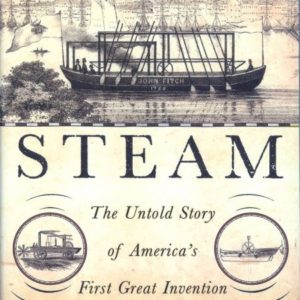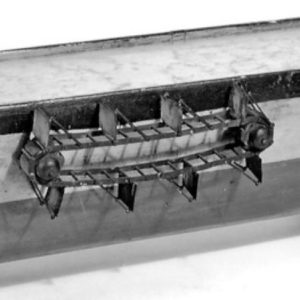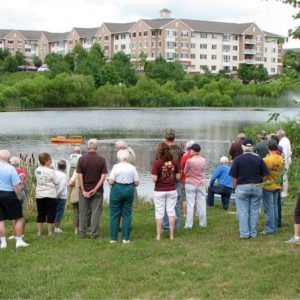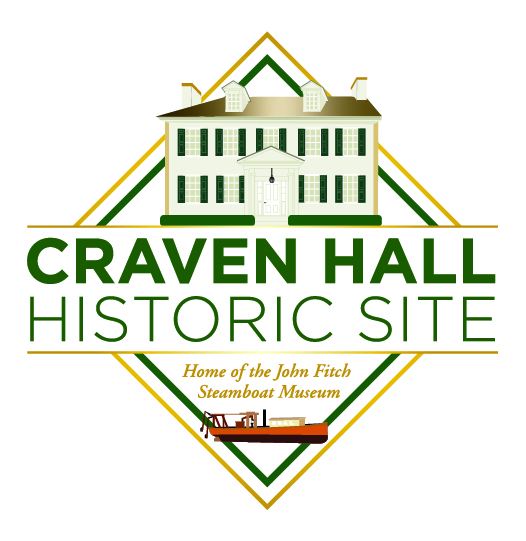The Story of John Fitch
An Adventuresome Life
John Fitch was born on a small farm near Hartford, Conn. in 1743. His father kept him out of school most of the time to work on the farm. In fact, John Fitch had less than two years of formal education in his entire life. Fortunately, he was “crazy for learning.” Fitch was an avid reader and excelled in mathematics.
To escape farm life, he became an apprentice to a clockmaker. But his master didn’t want to train a potential competitor, so Fitch was forced to do farm work until he was 21 and was released from his contract. It was an unhappy time.
Throughout his life, John Fitch was persistent. He was
determined to overcome any set back he might encounter.
But adversity was his nemesis.
Fitch wandered aimlessly until he settled in Trenton in 1767. There he became a prosperous silversmith in Trenton, New Jersey. Here is but one example of his fine craftsmanship on display in The Philadelphia History Museum (the former Atwater Kent Museum). Many have compared his skill as a silversmith with that of Paul Revere.
When the American Revolution started in 1775, Fitch joined the New Jersey militia as a gunsmith fitting bayonets onto muskets. But when the British occupied Trenton in 1776, Fitch lost everything. He fled to Warminster and eked out a living cleaning clocks. Then Fitch became a suttler or unauthorized provisioner, selling beer and tobacco to Washington’s troops in Valley Forge. But the colonial script he gathered was virtually worthless. He had lost out again.
Fitch needed another career. He heard that land in western Virginia could be surveyed and recorded, then sold with potentially huge profits. In 1780, he basically walked 700 miles from Warminster to what is now Bardstown, Ky. below Louisville. There he successfully surveyed and claimed 1,600 acres to sell to settlers as they came into the area. Fitch thought his future was financially secure. This was his 401(k) retirement plan. But it was not to be. Squatters eventually took over most of his land, leaving Fitch destitute yet again.
In 1782, Fitch walked to Pittsburgh. He planned to make big money by buying barrels of flour and selling them in New Orleans some 1,800 river miles away. Fitch joined a flotilla of flat boats and started to float down the Ohio River, but within four days, they were captured by Indians. Even though Cornwalis had surrendered in Yorktown the year before, the American Revolution dragged on. Fitch was turned over to the British in Detroit, and held prisoner near Montreal.
When released in late 1782, Fitch returned to Warminster and formed a land jobbing company. Over the next two years, Fitch and his team surveyed and claimed over 250,000 acres of the best land in Ohio. But the Land Ordinance of 1785 declared that such land had to be sold by Congress not by speculators like Fitch. He had lost everything and returned to Warminster utterly broke at the age of 42. Adversity had struck again, but Fitch was not a broken man.
A Visionary Legacy
If you have an idea, anything that’s visionary and people say, “It won’t work,” don’t give up. Stick with it!
In April 1785, while living in Warminster and suffering from rheumatism, John Fitch took a painful, four-mile walk home from the Neshaminy Meeting on Bristol Road that changed his life. When a riding chair rode by an inspiration came. Why couldn’t the elastic properties of steam be used to propel a carriage?
Never having seen one, Fitch spent hours inventing a steam engine on paper. However, he soon realized that the roads were too rough for such an engine to be used on a carriage – but what about a boat? Here was a way to move boats against the current. He took drawings of his steamboat engine to his good friend, the Rev. Nathaniel Irwin, who opened a book and showed Fitch a drawing of a steam engine invented in England to pump water out of mines.
Fitch was “amazingly chagrined” to learn that his steam engine had already been invented, but decided to press on. Working in the shop of a fellow craftsman, James Scout, near his lodgings in Warminster., Fitch quickly built a 23” model of a boat suitable for a steam engine, and tested its endless chain of side-mounted paddles in a stream in Joseph Longstreth’s meadow behind the current General Davis House on Street Road, a short distance east of Davisville Road in Upper Southampton Township.
Endorsements Sought in Vain from Famous People
Seeking endorsements and financial backing to build his boat, Fitch showed his plans to Benjamin Franklin, George Washington and members of the Continental Congress. They were impressed but offered no help. Disappointed, but not discouraged, Fitch presented his ideas, sketches and his boat model to the American Philosophical Society on September 27, 1785, less than six months after he conceived the idea.
With tireless effort, he raised money to get started by selling shares in his steamboat company. The British refused to sell their technology to the former colonies, so Fitch was forced to build a steam engine from scratch – no simple task without adequate manufacturing resources.
With great difficulty, he built and launched his first steamboat in the Delaware River in 1787. It was propelled by two sets of Indian canoe-like paddles mounted on either side.
Constitutional Convention Delegates Taken for a Ride
On August 22, 1787, Fitch demonstrated this remarkable steamboat to delegates to the Constitutional Convention meeting in Philadelphia, and took several for a memorable ride on the Delaware and Schuylkill Rivers. But they offered no support.
Unfazed, Fitch built a larger, better and faster steamboat incorporating a more compact water tube boiler and stern-mounted paddles. In 1790, it offered three round-trips a week between Philadelphia, Bristol and Trenton. In order to compete with stagecoaches, Fitch charged less and offered free beer, rum and sausages.
Although it lost money on every trip, the boat traveled nearly 3,000 miles that summer. It was a technological triumph, but a financial disaster. Unfortunately, backers abandoned Fitch, leaving him destitute.
Although Fitch, who had built and operated the world’s first commercial steamboat, was granted one of four patents for a steamboat signed by George Washington and Thomas Jefferson in 1791. Because his patent was not exclusive, it was worthless. However, Fitch did receive an exclusive patent in France, and traveled there in 1793 to build his steamboat, but it was not to be. The Reign of Terror and French Revolution were underway. Nobles Fitch counted on for financial support were more interested in escaping the guillotine than investing in a steamboat. So once again he failed and returned home penniless.
Fitch eventually retreated to Bardstown, KY to reclaim the 1,600 acres he had staked out before his ill-fated steamboat inspiration. However, squatters had taken over most of his land. While awaiting the outcome of legal battles, Fitch continued tinkering with steam engine ideas. He built a model with flanged wheels that could run forward and backward on rails. On display in the Ohio State Museum, this model is described there as the world’s first, self-propelled railway steam locomotive.
In failing health, Fitch collapsed one evening in 1798 in Bardstown. He died at the age of 55 and was buried in a pauper’s grave.
Fitch Had a Vision Beyond Steamboats
Fitch predicted that: “The day will come when vessels propelled by steam will cross the ocean! And I almost venture to prophesy that the same power will be utilized in moving vehicles on land.”
Fitch had led a turbulent, unhappy life. Robert Fulton realized the financial success of Fitch’s invention in 1807. Unlike Fitch, Fulton had the financial backing of a wealthy man, Robert Livingston, and a complete steam engine imported from England.
However, Fitch was the pioneer. He had built and operated the first commercial steamboat service in the world, and it all started in Warminster and Southampton Bucks County, Pennsylvania in 1785.








Museum Template – Mad UX © 2018. All Rights Reserved

